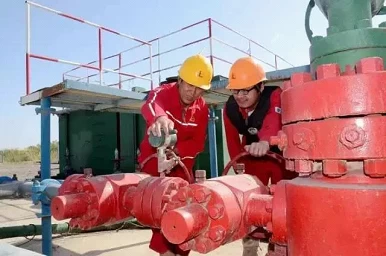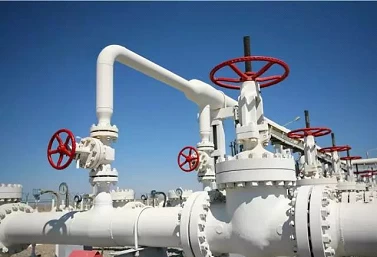Many chemical plant explosions have been caused by valves. Remember the 14 taboos of installing valv

Taboo 1
Hydrostatic test for winter construction at negativetemperature
Consequence: The tube freezes quickly due to the rapid freezing in thetube during the hydrostatic test.
Measures: Try to perform a hydraulic pressure test before thewinter application, and blow the water after the pressure test, especially thewater in the valve must be cleaned, otherwise the valve will freeze and crack.
The project must be carried out at a positive indoortemperature during the hydrostatic test in winter.
Blow clean water. When the hydrostatic test cannotbe performed, the test can be performed with compressed air.
The cryogenic will be done in valve factory for cryogenic valves by China DN20 PN16 ASTM A182-F316 cryogenic globe valve manufacturer.
Taboo 2
The piping system was not flushedcarefully before completion, and the flow and speed did not meet therequirements for piping flushing. Even hydraulic pressure test leaksinstead of flushing.
Consequences: The water quality does not meet the requirements of thepipeline system, and often causes the pipeline section to decrease or block.
Measures: Use the maximum juice flow in the system or the waterflow speed should not be less than 3m / s for flushing. It shall bequalified that the color and transparency of the water at the outlet and thecolor and transparency of the water at the inlet are consistent with visualinspection.
Taboo 3

Sewage, rainwater, and condensate pipes are concealedwithout a closed water test.
Consequence: May cause water leakage and loss to users.
Measures: The closed-water test work shall be strictly checked andaccepted in accordance with the specifications. Concealed sewage,rainwater, and condensate pipes, such as buried underground, inside theceiling, and between pipes, must be ensured to be leak-proof.
Taboo 4
In the hydraulic system strength testand tightness test of the piping system, only the pressure value and waterlevel change are observed, and the leakage inspection is not enough.
Consequence: Leakage occurs after the pipeline system runs, whichaffects normal use.
Measures: When the pipeline system is tested according to the designrequirements and construction specifications, in addition to recording thepressure value or water level change within the specified time, it isespecially necessary to carefully check whether there is a leakage problem.
Taboo 5
Butterfly valve flanges use common valveflanges.
Consequences: The size of the flange of the butterfly valve is differentfrom that of the ordinary valve, and some flanges have a small internaldiameter, while the butterfly valve has a large disc, which can cause the valveto fail to open or hard to open, causing damage to the valve.
Measures: The flange should be processed according to the actual sizeof the butterfly valve flange
Reliable valve supplier will give very professional suggestions on valve installing,Cowinns is one China C95800 ball valve manufacturer,we gave this type valve installation reminders to end user.
Taboo 6

There are no holes or embedded parts reserved in theconstruction of the building structure, or the size of the reserved holes istoo small and the embedded parts are not marked.
Consequences: During the construction of heating and sanitary engineering,picking up the building structure, or even cutting off the reinforced steelbars, affects the safety performance of the building.
Measures: Familiarize yourself with the construction drawings ofthe heating and sanitation project, and actively cooperate with theconstruction structure to reserve holes and embedded parts according to therequirements of the installation of pipes and supports and hangers, and referto the design requirements and construction specifications.
Taboo 7
When the pipe is welded, the pipemisalignment is not on a center line after the counterpart, there is no gap inthe counterpart, the thick-walled pipe is not shoveled, and the width andheight of the weld do not meet the requirements of the construction code.
Consequence: The misalignment of the tube is not directly on the centerline, which directly affects the welding quality and the quality of the lookand feel. There is no gap at the mouth, the bevel of thick-walled pipes isnot shovel, and the width and height of the welds do not meet the requirementsof strength when the welding does not meet the requirements.
Measures: After welding the pipe counterparts, the pipes must not bestaggered. There must be a gap on the center line of the counterparts.Thick-walled pipes must be shoveled. In addition, the width and height of thewelds should be welded in accordance with the requirements of the code.
Taboo 8
The pipeline is directly buried in frozensoil and untreated loose soil. The distance and location of the support pier ofthe pipeline are improper, even in the form of dry code bricks.
Consequence: Due to the unstable support of the pipeline, thepipeline was damaged during the compaction of the backfill soil, resulting inrework and repair.
Measures:The pipeline must not be buried in frozen soiland untreated loose soil. The distance between the pier should meet therequirements of the construction code, and the support pads should be firm,especially at the interface of the pipeline. The brick pier should bebuilt with cement mortar to ensure completeness and firmness.
Taboo 9
The expansion bolts used to fix the pipe bracket are ofinferior material. The hole diameter for installing the expansion bolts is toolarge or the expansion bolts are installed on brick walls or even light walls.
Consequence: The pipe support is loose, the pipe is deformed, or evenfalls off.
Measures: Qualified products must be selected for the expansionbolts. If necessary, samples should be tested and tested. The diameter of theexpansion bolts installed should not be greater than the outer diameter of theexpansion bolts by 2mm. The expansion bolts should be used on concrete structures.
Taboo 10
The flange and gasket of the pipe connectionare not strong enough, and the connecting bolts are short or thin indiameter. Rubber pipes are used for heat pipes, asbestos pads are used forcold water pipes, and double-layer pads or bevel pads are used. Flange gasketsproject into the pipes.
Consequence: The flange connection is not tight, even damaged, andleakage occurs. Flange gaskets protrude into the tube and increase waterresistance.
Measures: The flanges and gaskets for pipelines must meet therequirements of the design working pressure of the pipelines.
Rubber asbestos gaskets should be used as flange gasketsfor heating and hot water supply pipes; rubber gaskets should be used as flangegaskets for water supply and drainage pipes.
The gasket of the flange must not protrude into thepipe, and its outer circle is appropriate to the flange bolt hole. Noflange pad or several gaskets should be placed in the middle of the flange. Thediameter of the bolt connecting the flange should be less than 2mm than thediameter of the flange. The length of the protruding nut of the bolt rod shouldbe 1/2 of the thickness of the nut.
Taboo 11
Incorrect valve installation method.
For example, the water (steam) flow direction of the stop valveor check valve is opposite to the mark, the valve stem is installed downwards,and the horizontally installed check valve is installed vertically. Do not facethe inspection door.
Consequence: The valve fails, the switch isdifficult to repair and repair, and the valve stem often causes water leakage.
Measures: Install strictly in accordancewith the valve installation instructions. The open stem gate valve should beleft with the valve stem extended to open height. The butterfly valve fullyconsiders the turning space of the handle. The various valve stems cannot belower than the horizontal position, nor can they be downward. Theconcealed valve should not only be provided with an inspection door that meetsthe needs of valve opening and closing, but also the valve stem should face theinspection door.
Taboo 12
The specifications and models of the installed valves donot meet the design requirements.
For example, the nominal pressure of the valve is lessthan the system test pressure; the gate valve is used for the branch pipe ofthe water supply when the diameter is less than or equal to 50mm; the stopvalve for hot and dry pipes is used;
Consequences: Affects the normal opening and closing of the valve andadjusts resistance, pressure and other functions. It even caused the valveto be repaired during system operation.
Measures: Familiar with the application scope of various valves,and choose the specifications and models of the valves according to therequirements of the design. The nominal pressure of the valve should meetthe requirements of the system test pressure. According to therequirements of the construction code: a stop valve should be used for the pipediameter of the water supply branch pipe less than or equal to 50mm; a gate valveshould be used when the pipe diameter is greater than 50mm. Gate valvesfor hot water heating, dry, and vertical control valves should be used, andbutterfly valves should not be used for fire pump suction pipes.
Taboo 13
Before the valve is installed, the necessary qualityinspection is not performed as required.
Consequence: The valve switch is not flexible during the operation of thesystem, the closure is not strict, and the phenomenon of water leakage (steam)occurs, which causes rework repair and even affects the normal water supply(steam).
Measures: Before the valve is installed, the pressure strength andtightness test should be performed. The test shall be carried out byrandom inspection of 10% and not less than one in each batch (same brand, samespecification, same model).
For the closed-circuit valve installed on the main pipeto cut off, the strength and tightness test should be performed one byone. The strength and tightness test pressure of the valve shall complywith the "Code for Acceptance of Construction Quality of Building WaterSupply and Drainage and Heating Engineering" (GB 50242-2002).
Taboo 14
The main materials, equipment and products used inconstruction lack technical quality appraisal documents or product qualificationcertificates that meet the current standards issued by the state or theministry.
Consequences: The quality of the project is unqualified, there are hiddendangers of accidents, it cannot be delivered and used on schedule, and it mustbe reworked for repairs; causing delays in the construction period andincreased labor and material inputs.
Measures: The main materials, equipment and products used in watersupply, drainage and sanitation engineering should have technical qualityappraisal documents or product certifications that meet the current standardsissued by the country or the ministry; their product names, models,specifications, and national quality standards should be indicated Code, dateof manufacture, name and location of the manufacturer, inspection certificateor code of the manufactured product.
 +86 512 68781993
+86 512 68781993 


















